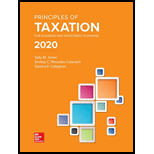
Principles Of Taxation For Business And Investment Planning 2020 Edition
23rd Edition
ISBN: 9781259969546
Author: Sally Jones, Shelley C. Rhoades-Catanach, Sandra R Callaghan
Publisher: McGraw-Hill Education
expand_more
expand_more
format_list_bulleted
Concept explainers
Textbook Question
Chapter 14, Problem 8QPD
Individuals who plan to bunch itemized deductions into one year can either postpone the payment of expenses from an earlier year or accelerate the payment of expenses from a later year. Which technique is preferable from a
Expert Solution & Answer
Want to see the full answer?
Check out a sample textbook solution
Students have asked these similar questions
Cost Account
Answer? ?
Need general account answer
Chapter 14 Solutions
Principles Of Taxation For Business And Investment Planning 2020 Edition
Ch. 14 - Prob. 1QPDCh. 14 - Prob. 2QPDCh. 14 - Why is the formula for computing individual...Ch. 14 - Discuss possible tax policy reasons why...Ch. 14 - Prob. 5QPDCh. 14 - Identify the reasons why individual taxpayers...Ch. 14 - Prob. 7QPDCh. 14 - Individuals who plan to bunch itemized deductions...Ch. 14 - Prob. 9QPDCh. 14 - Single individuals Sam and Zelle were married this...
Ch. 14 - Prob. 11QPDCh. 14 - Under the current rate structure, a high-income...Ch. 14 - Prob. 13QPDCh. 14 - Prob. 14QPDCh. 14 - Prob. 15QPDCh. 14 - Prob. 16QPDCh. 14 - Determine Ms. Arnouts filing status in each of the...Ch. 14 - Determine Mr. Jenkinss 2019 filing status in each...Ch. 14 - Mr. and Mrs. Keppner file a joint income tax...Ch. 14 - Prob. 4APCh. 14 - Ms. West is an unmarried individual. Determine if...Ch. 14 - Mr. and Mrs. Ohlson file a joint income tax...Ch. 14 - Ms. Gomez earned a 91,250 salary, and Mr. Hill...Ch. 14 - Mr. Olaf earned an 89,000 salary, and Mrs. Olaf...Ch. 14 - Mr. and Mrs. Daku have the following income items....Ch. 14 - Mr. and Mrs. Simpson have the following income...Ch. 14 - Ms. Timmons, an unmarried individual, has the...Ch. 14 - Prob. 12APCh. 14 - Mr. Coleman, an unmarried individual, has the...Ch. 14 - Mr. and Mrs. Ludwig have the following income...Ch. 14 - Mr. Rogers, an unmarried individual, had the...Ch. 14 - Ms. Ellis, a single individual, has 115,000...Ch. 14 - Ms. Barnes, an unmarried individual, has 196,400...Ch. 14 - Prob. 18APCh. 14 - Mr. Garrett, a single taxpayer, has 15,700 AGI....Ch. 14 - Danny Liu is 20 years old and is considered a...Ch. 14 - Mr. and Mrs. Palio celebrated the birth of their...Ch. 14 - Mr. Masons salary was 397,000, and Mrs. Masons...Ch. 14 - Prob. 23APCh. 14 - Callie is the 11-year-old daughter and dependent...Ch. 14 - Ms. Gleason, an unmarried taxpayer, had the...Ch. 14 - Mr. and Mrs. Chaulk have three dependent children,...Ch. 14 - Mr. and Mrs. Alexander have two dependent...Ch. 14 - Mr. and Mrs. Coulter have four dependent children,...Ch. 14 - On March 31, Mr. Reinhardt quit his job with MT...Ch. 14 - Mr. and Mrs. Lovejoy are married with no dependent...Ch. 14 - Mr. and Mrs. Kigalis AGI (earned income) was...Ch. 14 - Prob. 32APCh. 14 - Prob. 33APCh. 14 - In January, Ms. Northcut projects that her...Ch. 14 - Mr. and Mrs. Brown report taxable income of...Ch. 14 - Prob. 1IRPCh. 14 - Prob. 2IRPCh. 14 - Prob. 3IRPCh. 14 - Mr. Tilton is a 20-year-old college student. This...Ch. 14 - Prob. 5IRPCh. 14 - Prob. 6IRPCh. 14 - Prob. 7IRPCh. 14 - Prob. 8IRPCh. 14 - Prob. 9IRPCh. 14 - Prob. 10IRPCh. 14 - Mr. and Mrs. Marceleno own a sole proprietorship...Ch. 14 - Prob. 12IRPCh. 14 - Prob. 1RPCh. 14 - Prob. 2RPCh. 14 - Mr. and Mrs. Wilson are married with one dependent...Ch. 14 - Prob. 2TPC
Knowledge Booster
Learn more about
Need a deep-dive on the concept behind this application? Look no further. Learn more about this topic, accounting and related others by exploring similar questions and additional content below.Similar questions
- Carla Vista Co. sells coffee beans, which are sensitive to price fluctuations. The following inventory information is available for this product at December 31, 2017: Coffee Bean Units Unit Cost Market Market Coffea arabica 12,000 bags $ 5.90 $ 5.87 Coffea robusta 5,000 bags 3.40 3.50 Calculate Tascon's inventory by applying the lower-of-cost-or-market basis.arrow_forwardNeed answer the accounting question not use ai and chatgptarrow_forwardHi expert please give me answer general accountingarrow_forward
- Please provide this question solution general accountingarrow_forwardThomspson company sold manufacturing equipment solve this accounting questionsarrow_forwardThe Jewel Fool had the following inventory items on hand at the end of the year. Quantity Cost per Item Market Value per Item Necklaces 10 $ 74 $ 69 Bracelets 50 39 59 Required: Determine the lower of cost or market per unit and the total amount that should be reported on the balance sheet for each item of inventory. Lower of Cost or Market Per unit Total Amount Reported Necklaces Bracelets Total $ EAarrow_forward
- On March 1, 2019, Baltimore Company's beginning work in process inventory had 9,500 units. This is its only production department. Beginning WIP units were 50% done as to conversion costs. Baltimore introduces direct materials at the beginning of the production process. During March, a total of 22,400 units were started and the ending WIP inventory had 6,200 units which were 60% done as to conversion costs. Baltimore uses the weighted average method. Use this information to determine for March 2019 the equivalent units of production for conversion costs. (Round the answer to the nearest whole number of units.)arrow_forwardPlease provide correct solution for this accounting questionarrow_forwardSubj. General Accountarrow_forward
arrow_back_ios
SEE MORE QUESTIONS
arrow_forward_ios
Recommended textbooks for you
 Cornerstones of Financial AccountingAccountingISBN:9781337690881Author:Jay Rich, Jeff JonesPublisher:Cengage Learning
Cornerstones of Financial AccountingAccountingISBN:9781337690881Author:Jay Rich, Jeff JonesPublisher:Cengage Learning


Cornerstones of Financial Accounting
Accounting
ISBN:9781337690881
Author:Jay Rich, Jeff Jones
Publisher:Cengage Learning


Capital Budgeting Introduction & Calculations Step-by-Step -PV, FV, NPV, IRR, Payback, Simple R of R; Author: Accounting Step by Step;https://www.youtube.com/watch?v=hyBw-NnAkHY;License: Standard Youtube License